The temperamental Tokay Gecko is a tough yet brightly colored reptile that has brought life to the rooms of many reptile enthusiasts.
They come from the hot and humid forests of Southeast Asia, and are given their unique name based on the “to-kay” sound they make during mating.
These lizards are often blue with bright red or black spots, and can range from 8 inches to 16 inches in length. Beginner herpetologists should be careful handling this Gecko as they have a nasty bite!
Tokay Geckos are relatively easy to keep happy when they are in their tanks. Their diet consists of only insects and, since they are nocturnal, do not require extra lighting.
Despite their easy husbandry, these animals can be very aggressive, so they require patience and expertise to handle. If you are a reptile enthusiast looking for your next challenge, then continue reading to learn how to care for them.
Are Tokay Geckos Good Pets?
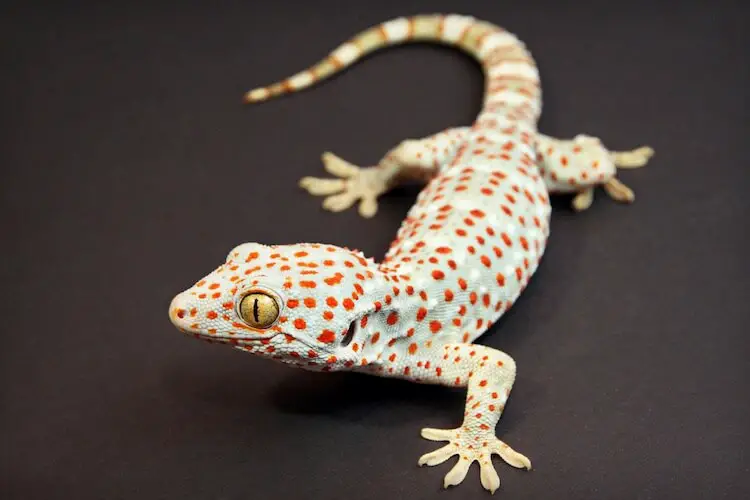
The Tokay Gecko is found anywhere from northeastern India to the Indo-Australian Archipelago. These lands consist of deciduous and tropical forests.
Tokays are happy to live in the trees, or even among made-made environments, such as in buildings in larger towns and cities where insects are abundant. Many are found in residential areas in southern Florida and Hawaii. This is likely due to shipping accidents in the pet trade introducing them to these areas. But they thrive there and can even be used for pest control!
They have a very distinguished look when compared with other geckos. They are often blue-gray in color and always come with either bright red or black spots. They have big, bright eyes that have skinny slit-like pupils.
Reptile owners love them for this unique appearance and for their “to-kay” sound that they make during mating season.
As unique as their appearance is, these geckos are also known for their very strong bite! The behavior of this gecko is naturally aggressive. They are territorial and do not like being handled.
They are not ideal pets for first-time reptile keepers or anyone looking for a friendly reptile. They also do not get along with other reptiles, and strictly live alone.
| Quick Facts | |
|---|---|
| Common Names | Gekko |
| Scientific Name | Gekko Gecko |
| Adult Size | 8 to 16 inches, 140 to 200 grams |
| Lifespan | 10 years |
| Diet | Crickets, mealworms and cockroaches |
| Tank Size | 30 gallon glass tank with heating |
| Humidity & Temperature | 80℉-87℉ and 60%-80% humidity |
| Popular Alternatives | Common House Gecko, Forest Gecko |
Tokay Gecko Care
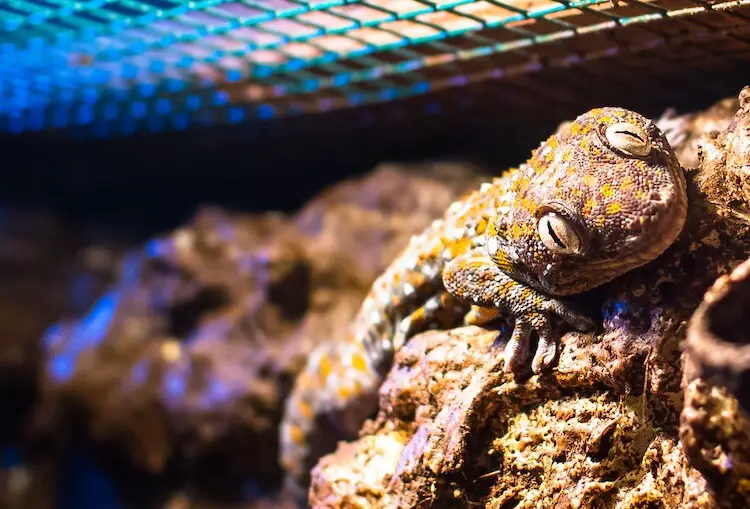
The Tokay Gecko has a vast range of geography they live in. He resides in India, Indochina, and the Indo-Oceanic areas. Some of the terrain is mountainous, while plains cover some of it. The climate is mostly tropical and subtropical, with high humidity and temperatures.
Some have also been introduced to Hawaii and southern Florida though the illegal pet trade. The forests of these areas range between tropical and deciduous (trees that lose their leaves). Because of this, they can thrive in both natural and man-made environments.
Their habitat can range from the trees to outside of man-made buildings. They will tend to stay where there is the most food.
Tokay Gecko Habitat and Tank
This lizard will thrive in a 30 gallon glass tank. The glass gives them lots of opportunities to climb on the walls of their enclosure.
Newborn hatchlings can be housed together in a smaller 10 gallon tank, but they should be relocated to their adult enclosures as soon as they start growing or showing signs of aggression towards each other (which may be within six months).
Because this is a very territorial and solitary reptile, they will do well if they have hiding places such as logs or bushes.
Lighting and Heating
Since Tokays are nocturnal, they do not need a basking rock. He will do just fine in natural lighting, as long as his Circadian rhythm is not interrupted by artificial light at night.
He does not require a UVB light either, provided he is fed a calcium and Vitamin D3 supplement.
Although he is not a fan of light, the tank still needs to be hotter than room temperature. These geckos seek temperatures of around 80℉-87℉. Because of this, under-the-tank heaters or ceramic heaters work very well to easily raise the tank temperature by about 10℉ while avoiding unnecessary light.
A thermometer should be kept within the tank to monitor when the heater should be on. A hooded lamp is not required as you do not need a light source.
The tank’s humidity should be kept between 60% to 80% which can be achieved by misting every day. After misting, the glass walls must be wiped down to allow your gecko to climb them. Geckos have a harder time climbing on wet surfaces, but the right humidity-to-temperature ratio also helps their climbing ability.
Substrate
Tokay Geckos are not picky about the substrate in their tank because they thrive in man-made environments. Soil will help any live plants in the enclosure, but these Geckos would be just as happy on some paper towels or soft wood shavings.
Substrates that retain moisture will help keep the humidity levels where they need to be.
The substrate should be changed frequently enough to prevent any bacterial growth from accumulating and creating an unhealthy environment for your pet.
| Tank Tips | |
|---|---|
| Tank Type | Glass tank |
| Heating | Under tank heater or ceramic heater |
| Best Substrate | Soft wood shavings |
Feeding A Tokay Gecko
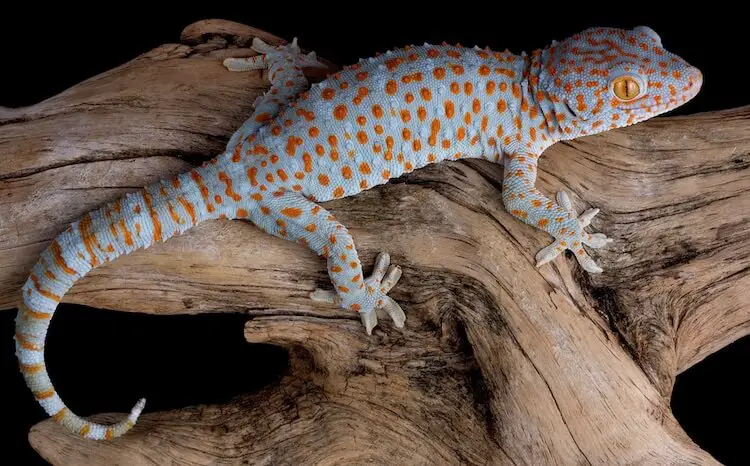
In the wild, Tokays are natural carnivores, eating mostly smaller insects and reptiles, including moths, grasshoppers, crickets, and beetles. They are not fussy about what they eat, and will mostly consume whatever they can get ahold of.
They are a sit-and-wait predator, meaning they wait for food to walk by rather than actively hunting for it. Because Tokays are nocturnal, they primarily come out in the evening to feed. At this time, insects are abundant.
In their native habitats, Tokay Geckos may dwell in populated areas or in the forests. In either habitat, they are not picky about what kind of bug may wander their way. They wait for prey to come by, and then attack. They do this because the food they capture normally does not provide enough energy for them to actively hunt.
As with any pet, a balanced diet is important. In captivity, they will be perfectly happy eating bugs from the pet-store. These can include crickets, cockroaches, beetles, mealworms, or grubs. They should eat several insects a day.
Supplements of calcium will prevent metabolic bone disease and keep your gecko strong, and a Vitamin D3 supplement is also ideal because Tokay Geckos are nocturnal and have a hard time synthesizing it on their own. Both of these supplements can be dusted onto their food.
Finally, a bowl of fresh water should always be left out for your geckos to drink.
| Diet Summary | |
|---|---|
| Insects | Several crickets or mealworms a day |
| Fruits | 0% |
| Vegetables | 0% |
| Supplements Required | Calcium and Vitamin D3 |
How To Keep Them Healthy
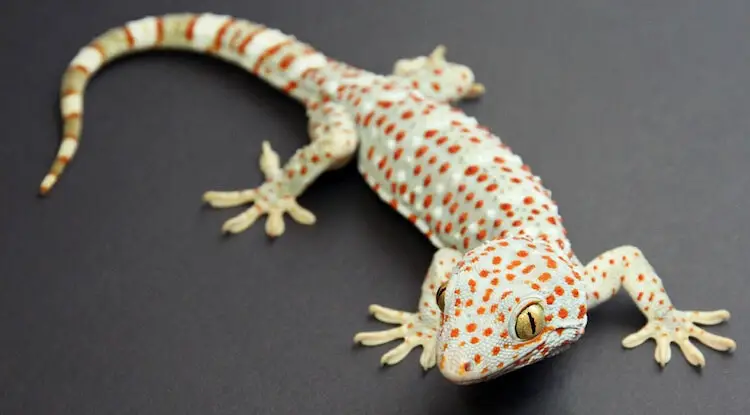
Like many lizards, this pet contains bacteria in their feces, specifically enterobacteria. This category of bacteria contains those that are common causes of infection and food poisoning, such as E. coli. The bacteria found in Tokays have been shown to be resistant to many antibiotics.
It is very important for your health, and your pet’s, that you wash your hands before and after handling.
Tokay Geckos are also aggressive and are likely to bite, so wearing thick gloves may protect your hands if you need to handle them. However, they should only be handled if absolutely necessary.
Because they do not like handling and shed on their own anyway, bathing them is not recommended. If they are healthy and are eating right diet they will shed regularly.
Most Geckos come from naturally humid environments, and this lizard is no exception. You should be misting their enclosure daily.
Their waste should look normal; solid brown with a white part that is essentially solidified urine. It is okay if it is runny occasionally, but if it is constantly runny, there may be an underlying health concern.
Their feces contain bacteria that are potentially pathogenic, so it is important that waste is cleaned from the tank every week or so to prevent infection.
Tokay Gecko Lifespan
This lizard lives for around 10 years in captivity. They are generally healthy reptiles, when taken care of properly. An unbalanced calcium diet can lead to health problems such as metabolic bone disease which will reduce their lifespan.
| Signs They Are Healthy | Sickness Symptoms |
|---|---|
| Hiding/limited appearance during the day | Doesn’t move over the course of a couple days |
| Vocalizing, bright and alert at night | Stops defecating |
| Defecating regularly | No resistance to being picked up |
Are Tokay Geckos Aggressive?
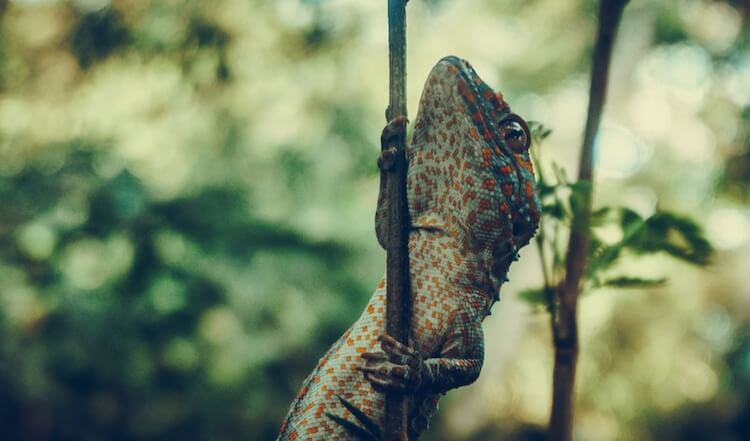
In the wild, Tokays are a very solitary reptile that prefers to be by itself. They are very territorial and will defend themselves, their homes and food. They are quick and have a strong bite, and will attack something that threatens them.
When threatened, Geckos will emit a hissing or croaking noise and flee. They may lose their tail if necessary. A signal of intimidation may sound like a brief and short bark.
They can, and will, fight with members of the same sex, and will only interact with members of the opposite sex while breeding.
Unfortunately, Tokay Geckos are likely to act very similarly while in captivity. They have very fierce attitudes and many herpetologists struggle to handle them. If they feel threatened by their owner, they will bite, and are among some of the toughest reptiles to handle.
Because they are nocturnal, you will rarely see your lizard during daylight hours. They may start coming out around the evening and will be asleep by the time the sun rises in the morning.
Handling
Tokay Geckos prefer to avoid interacting with people.
They should only be handled when necessary, and only with extreme caution. They cannot be housed with other reptiles either. They are very territorial and prefer their own space.
Because they come from tropical areas, Tokays do not hibernate, however they do have a peak breeding season around April and May.
Appearance
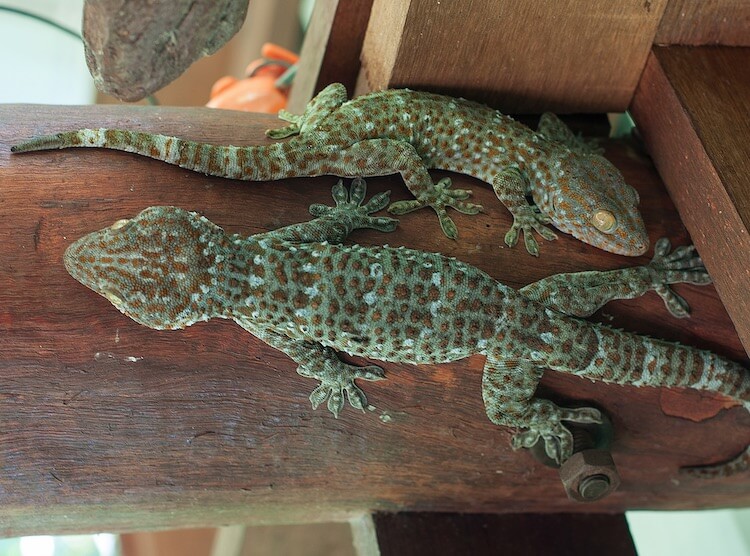
Tokay Geckos have thick, cylindrical bodies and tails that detach if they are threatened. These tails will grow back in about three weeks, but won’t be as long as the original.
Tokays have incredibly strong grips because of hair-like projections called “setae” on their toes that help them stick to nearly any surface.
A unique feature to this popular gecko is his third eye. This eye is hardly noticeable and is associated with the pineal gland in the brain. It doesn’t capture imagery but is sensitive to light.
Tokay Gecko Size
The main noticeable difference between males and females is their size:
- Adult males can be 8-12 inches
- Adult females can grow to 13-16 inches
On average both sexes will weigh 140 to 200 grams. When a hatchling is born, they are two to three inches in size and will grow to adult size within 18 months.
Colors
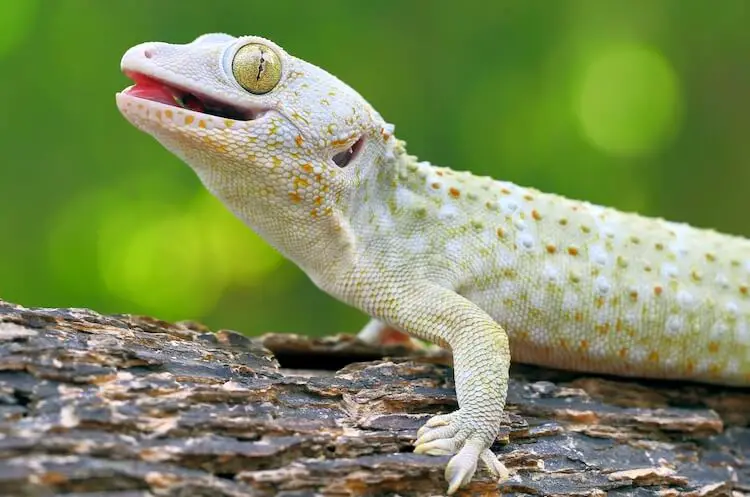
Tokay Geckos have very unique colors that complement their spotted patterns, and they have two different morphs:
- Black-spotted Tokays are smaller and darker than Red-spotted Tokays. They have a darker gray color and are commonly found in Southern Yunnan and northern Vietnam.
- Red-spotted Tokays are found in southeast Asia, are larger, a lighter blue-gray in color, and have bright, eye-catching red spots.
Tokay Geckos Hatchlings
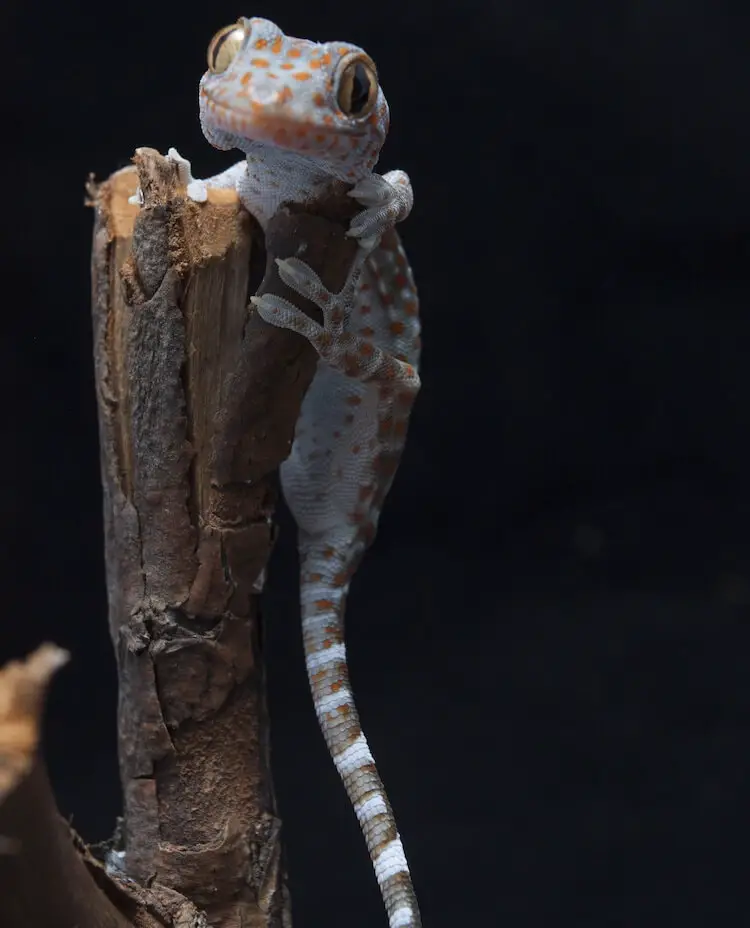
The mating call of a male Tokay Gecko is how he earned his name. At night, males can be heard calling to females with their “To-Kay”. They will often start vocalizing in April and start declining after June. These couple months mark the length of the breeding period for Tokays.
During this period, Tokays will secrete fluids from their femoral pores to attract mates. Over the course of the breeding period, both males and females will breed multiple times. Two eggs are laid per clutch.
When eggs are laid, they are watched over by both the parents until they hatch. The eggs will hatch after about three months and hatchlings will be about 2-3 inches long. Once born, they eat the outer covering of their skin and are self-sufficient.
Why Is A Tokay Gecko Expensive?
Unfortunately, they are used in medicine in Chinese culture, making them popular in the illegal pet trade. They are generally between $15 and $100 USD making them a relatively inexpensive reptile. There are many breeders, but make sure you do your research.
Care Guide Summary
| Pros | Cons |
|---|---|
| Known for their unique colors and voices | Can be very solitary and aggressive |
| Easy diet to maintain (insects that can be bought at a pet store) | Very quick and have a powerful bite |
| Inexpensive to adopt | Carry antibiotic-resistant bacteria |
The Tokay Gecko is a unique-looking reptile that can bring color to a reptile enthusiast’s home. However, they are not for everyone.
Tokays are extremely territorial and aggressive, so they will bite! They are therefore best suited to someone who has lots of experience handling difficult lizards, and they are certainly not for beginners. A Gecko which is less defensive is the Crested Gecko, which tolerates handling when it learns to trust its owner.
Though the temperament of a Tokay is a force to be reckoned with, they have relatively basic husbandry requirements:
- They eat mostly any kind of bug or insect from your local pet or bait store
- They are not picky about where they live (in terms of foliage)
- They do require some heating, but this is manageable with a good heater and a thermometer
If you do choose to bring this lizard into your home, do so at your own risk! They may be unique creatures, but they will only do well in a home that is prepared to take care of it. Let us know how you get on below.

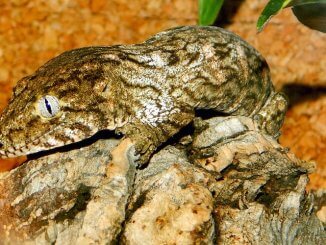
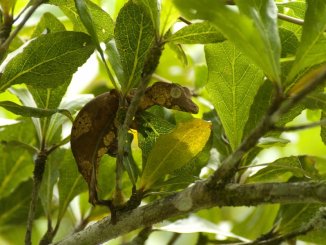
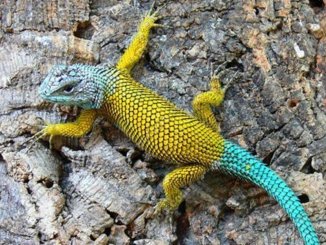
I have found them to be very social. I see many beachside in Florida and they are usually out as a pack. I’ve seen over six of them (adults and younger) laying on top of each other in the nook of a tree. There probably wasn’t more than one mature male in the pack though. I keep two females and one male and they are inseparable in a 75-gallon terrarium.
i inherited one from my son… i need to move it to a bigger tank and would like any idea on how to do this safely, for both of us.
As mentioned in the section on ‘how to keep them healthy’, this species much prefers not to be handled. Moving to a bigger tank is nothing too complex for you, although it may take some time for him to adapt.
In very simple terms here’s a few steps:
Clean and then decorate his new tank, consider moving some of his favorite features from the old tank into the new one. When his new home is ready you can either create a passage from the old to the new tank (but if they are opened from the top this could be difficult), or alternatively, the good old throw-in.
Spent some time next to him, perhaps with your hand inside his enclosure but minding your own business.
Approach the animal slowly, with little eye contact, retreating the hand when he looks scared (but don’t take it out). He needs to know you’re not there to hurt him. At some point you have got to go for it.
Pick him up gently and lay it on your hand, do not hold the tail, limbs or head and place him in his new tank. I wouldn’t try to use food as bait.